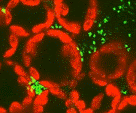Plant Pathology, Department of

Department of Plant Pathology: Faculty Publications
Document Type
Article
Date of this Version
2014
Citation
In: H. W. Dehne, H. B. Deising, U. Gisi, B. Fraaije, U. Gisi, D. Hermann, A. Mehl, E. C. Oerke, P. E. Russel, G. Stammler, K. H. Kuck, and H. Lyr (eds), Modern Fungicides and Antifungal Compounds, Vol. VII, pp. 263-268.
Abstract
Three fungicide-sensitive Monilinia fructicola isolates were exposed in weekly transfers of mycelia to a dose gradient of a DMI and a QoI fungicide (azoxystrobin) in solo or mixture treatments and fungicide sensitivity as well as genetic changes were assessed. Isolates showed a faster reduction in sensitivity (higher resistance factors) to azoxystrobin than to SYP-Z048; this process was slower in the mixture treatment. The decrease of fungicide sensitivity was not a heritable trait. Genomic mutagenesis at 8 of 15 microsatellite loci was evidenced in one of three isolates tested after exposure to azoxystrobin. These non-coding regions of the genome either showed single repeat additions or deletions, or large insertions or deletions, suggesting sublethal exposure to azoxystrobin may increase the rate of genomic mutagenesis. Mutagenesis was only observed after exposure to azoxystrobin, which may be dependent on the mode of action of this fungicide, however, more rigorous experimentation is needed before such conclusions can be drawn from these results.
Included in
Genetics and Genomics Commons, Other Plant Sciences Commons, Plant Biology Commons, Plant Pathology Commons


Comments
Copyright © 2014 Deutsche Phytomedizinische Gesellschaft.